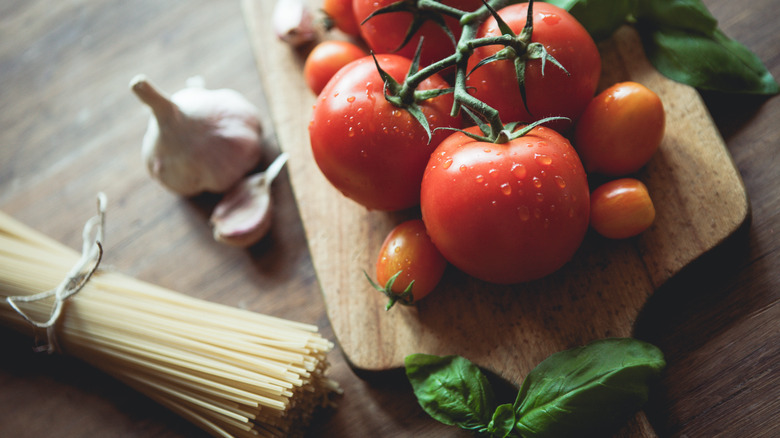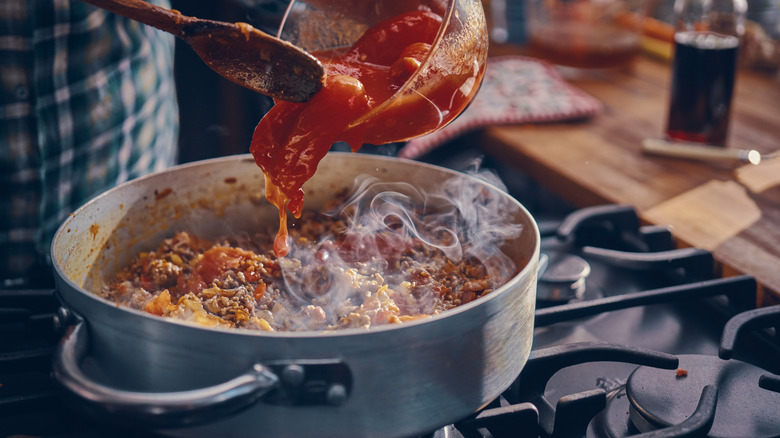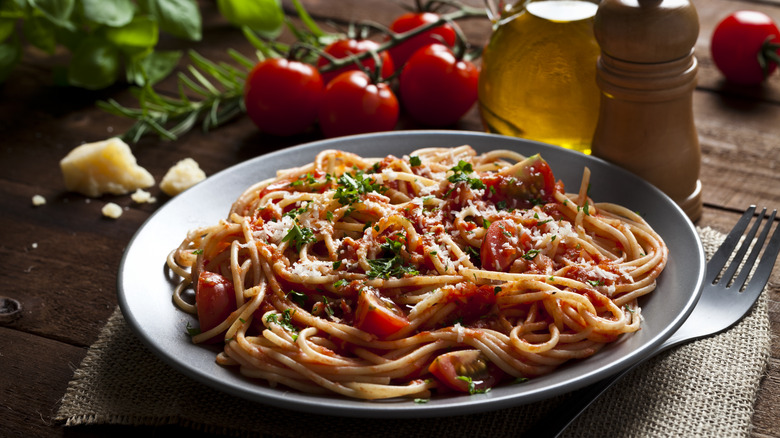The Purported History Of Pairing Pasta And Tomatoes
Rags to riches is a common theme in culinary history. Sweetbreads, for instance, are served on the menus of many fine dining establishments, but they come from the often-discarded parts of animals: the offal. Same deal with pâté and bouillabaisse. It might seem like a given today, but believe it or not, pairing pasta and tomatoes was also originally inspired by socioeconomic demographics and a complicated historical framework — and foodies have only been pairing them for a little under two centuries.
Tuscany embraced the combo as a way to incorporate local ingredients that could be grown in home gardens, a thrifty gastronomic practice known as "la cucina povera," aka "poor people's food" (the classic French dish ratatouille was created with the same motivation). By the 19th century, tomatoes and pasta cemented themselves as an Italian culinary pillar, and the rest is (literally) history. But, over the past century and a half, it's been a long and winding road from subsistence farms to Michelin-star trattorias.
17th century foodies thought they were too good for tomatoes
The tomato plant first landed on Italian shores in the mid-1500s when Spanish explorers brought it over from the Aztec empire. But, it took a while for foodies to warm up to the new and unfamiliar fruit, regarding it with suspicion and disdain for how close it grew to the dirt.
The first ever recorded recipe for tomato sauce didn't crop up until 1694 when Antonio Latini of Napoli wrote "Lo Scalco alla Moderna." In the recipe, Latini framed tomato sauce as an acidic complement to otherwise bland dishes, especially boiled meat. Home cooks today mirror Latini's reverence for the versatile fruit, with some cooks even favoring a particular type of tomato for their favorite recipes. Macaroni and tomatoes has even emerged as a popular Southern dish, often mixed with bacon grease and onions. But, when Latini first wrote his book, foodies in Italy were still skeptical.
As the "Moderna" in the 1694 book's title might suggest, tomatoes were still considered a luxury food item (a novelty, at best) and therefore were only being eaten by the upper class through the 16th century. Yet, in a roundabout way, tomatoes made their way into the kitchens of less affluent foodies because, in 17th-century Italy, eating vegetables was associated with being poor. Rich foodies shunned tomatoes as a symbol of poverty, leaving it up to pastoral home cooks to revolutionize the ingredient into the global staple it is today.
The enduring legacy of Tuscan cucina povera
The cooking style was revolutionized by regional variations, but at its core, Tuscan cucina povera is a craft of personal experiments rooted in necessity and minimizing food waste during times of scarcity. In Tuscany, cucina povera dishes are characterized by a minimal lineup of ingredients prepared in a way that creates a huge flavor. Dishes star ingredients that could be found on the farms of the farmers who turned them into legendary, centuries-old dishes emblematic of their country: legumes, meat, vegetables, bread, and spices. As Dr. Eva Del Soldato, Tuscany native and associate professor of romance languages at the University of Pennsylvania, tells CNN, "Tuscan cuisine is based on not wasting anything, so if you have leftover meat, you cook it the following day with tomato — giving it more flavor with the tomato sauce. I think this obsession with not wasting food is very typical of Italian culture."
This sentiment is reflected in countless dishes that foodies around the world still enjoy today — and pasta with tomatoes is only the beginning — proving that what was once the food of the poor is now food for just about everyone.


